Expressionism was a modern artistic movement, originating in Germany at the beginning of the 20th century. Its typical trait is to present the world solely from a subjective perspective, distorting it radically for emotional effect in order to evoke moods or ideas. Expressionist artists sought to express meaning or emotional experience rather than physical reality.
The Expressionist emphasis on individual perspective has been characterized as a reaction to positivism and other artistic styles such as Naturalism and Impressionism. The style originated principally in Germany and Austria. The Expressionists had many influences, among them Edvard Munch, Vincent van Gogh, and African art. They were also aware of the work being done by the Fauves in Paris, who influenced Expressionism’s tendency toward arbitrary colors and jarring compositions. In reaction and opposition to French Impressionism, which emphasized the rendering of the visual appearance of objects, Expressionist artists sought to portray emotions and subjective interpretations. It was not important to reproduce an aesthetically pleasing impression of the artistic subject matter, they felt, but rather to represent vivid emotional reactions by powerful colors and dynamic compositions.
American Expressionism and American Figurative Expressionism, particularly the Boston figurative expressionism, were an integral part of American modernism around the Second World War. Major figurative Boston Expressionists included: Karl Zerbe, Hyman Bloom, Jack Levine, David Aronson. The Boston figurative Expressionists post World War II were increasingly marginalized by the development of abstract expressionism centered in New York City. After World War II, figurative expressionism influenced worldwide a large number of artists and styles. Thomas B. Hess wrote that “the ‘New figurative painting’ which some have been expecting as a reaction against Abstract Expressionism was implicit in it at the start, and is one of its most lineal continuities.
Abstract Expressionism is an American post–World War II art movement in American painting, developed in New York in the 1940s. It was the first specifically American movement to achieve international influence and put New York City at the center of the western art world, a role formerly filled by Paris. Although the term “abstract expressionism” was first applied to American art in 1946 by the art critic Robert Coates, it had been first used in Germany in 1919 in the magazine Der Sturm, regarding German Expressionism. In the United States, Alfred Barr was the first to use this term in 1929 in relation to works by Wassily Kandinsky.
Neo-expressionism is a style of modern painting and sculpture that emerged in the late 1970s and dominated the art market until the mid-1980s.
The Most Influential Expressionist Painters
Edvard Munch (1863-1944) was a Norwegian painter and print-maker whose intensely evocative treatment of psychological themes built upon some of the main tenets of late 19th-century Symbolism and greatly influenced German Expressionism in the early 20th century. One of his most well-known works is The Scream of 1893.
https://www.artsy.net/artist/edvard-munch

When Munch reached for the sublime in his art, as he did in every period of his career, he found the perfect expression for his inmost feelings and thoughts, whether his medium was painting or printmaking. All his production—masterpieces, incomplete sketches, and designs—was permeated by the same poignant, impressionable sensitivity, and this sensitivity made Edvard Munch first and last a portrayer of man. He was a painter driven by an all-compelling need to express himself.
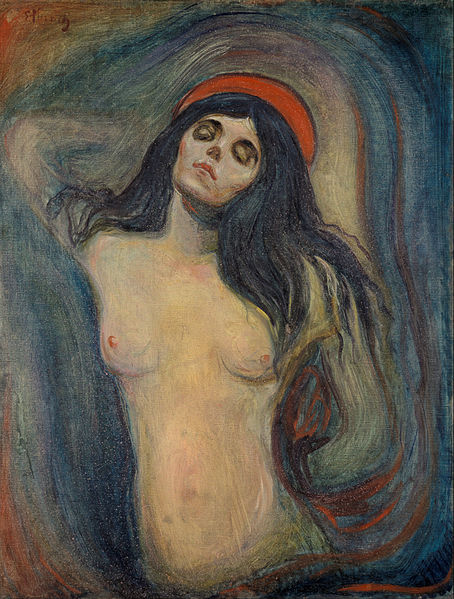
- Edvard Munch
- Wassily Kandinsky
- Franz Marc
- Käthe Kollwitz
- Amedeo Modigliani
 Käthe Kollwitz (1867 – 1945) was a German painter, print-maker, and sculptor whose work offered an eloquent and often searing account of the human condition, and the tragedy of war, in the first half of the 20th century. Her empathy for the less fortunate, expressed most famously through the graphic means of drawing, etching, lithography, and woodcut, embraced the victims of poverty, hunger, and war. Initially her work was grounded in Naturalism, and later took on Expressionistic qualities.
Käthe Kollwitz (1867 – 1945) was a German painter, print-maker, and sculptor whose work offered an eloquent and often searing account of the human condition, and the tragedy of war, in the first half of the 20th century. Her empathy for the less fortunate, expressed most famously through the graphic means of drawing, etching, lithography, and woodcut, embraced the victims of poverty, hunger, and war. Initially her work was grounded in Naturalism, and later took on Expressionistic qualities.
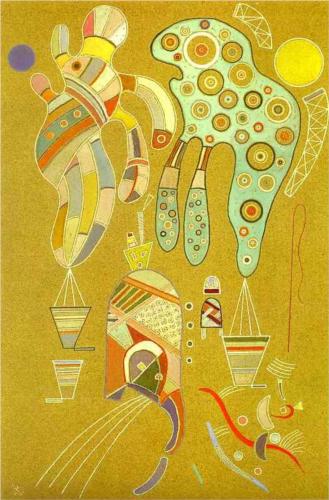
Wassily Kandinsky (1866-1944) was an influential Russian painter and art theorist. He is credited with painting the first purely abstract works. Born in Moscow, Kandinsky spent his childhood in Odessa. He enrolled at the University of Moscow, studying law and economics. Successful in his profession—he was offered a professorship (chair of Roman Law) at the University of Dorpat—he began painting studies (life-drawing, sketching and anatomy) at the age of 30.
In 1896 Kandinsky settled in Munich, studying first at Anton Ažbe’s private school and then at the Academy of Fine Arts. He returned to Moscow in 1914, after the outbreak of World War I. Kandinsky was unsympathetic to the official theories on art in Communist Moscow, and returned to Germany in 1921. There, he taught at the Bauhaus school of art and architecture from 1922 until the Nazis closed it in 1933. He then moved to France where he lived for the rest of his life, becoming a French citizen in 1939 and producing some of his most prominent art. He died at Neuilly-sur-Seine in 1944.
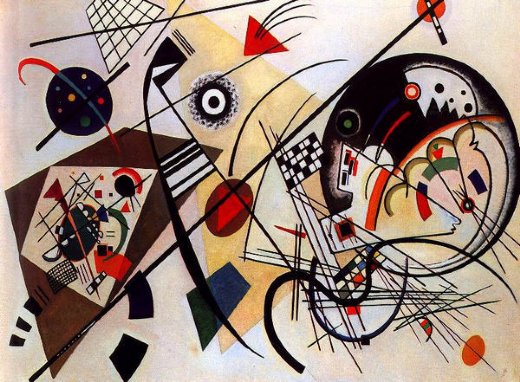
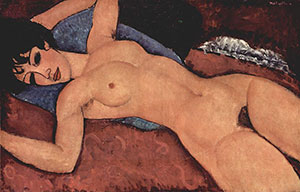
Source: DirectMedia Publishing GmbH
Amedeo Modigliani (1884 – 1920) was an Italian expressionist painter and sculptor who worked mainly in France. Similar to Vincent van Gogh, Modigliani spent most of his career battling the stress of failure as an artist, although his remarkable expressionist style guarantees him a unique place in the modern history of art. He is known for portraits and nudes in a modern style characterized by elongation of faces and figures, but were sadly unappreciated during his lifetime. He died at age 35 in Paris of tubercular meningitis.
Modigliani was born into a Jewish family in Italy. In 1906 he moved to Paris, and became interested in the Post-Impressionist paintings of Paul Cézanne. Modigliani had a deep respect for Picasso as an artist. He used some aspects of Picasso’s cubism, and the way Picasso would depict his artistic friends during his blue period would remain one of the main themes in Modigliani’s own work. The strong influence of Paul Cezanne is also evident in his art.
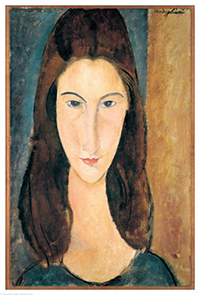
Between 1915 and 1919, Modigliani produced all of his greatest portrait paintings, and developed a unique style in his portrait painting: the necks of his subjects were elongated, their mouths pursed, the eyes almond shaped. The backgrounds were neutral and economical, but the portraits were able to convey the personality of each individual sitter.
Modigliani also produced some deeply sensuous nudes, including Seated Nude (Courtauld Institute Galleries, London, 1916). Some aquaintances of the artist have claimed that it was only when he was drunk on absinthe, that he was able to paint his masterpieces. His works now sell for tens of millions of dollars each. http://www.modigliani-foundation.org/
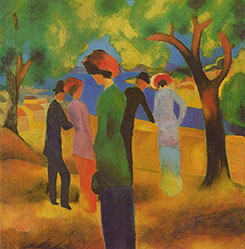
– August Macke
August Macke (1887 – 1914) was one of the leading members of the German Expressionist group (The Blue Rider). He lived during a particularly innovative time for German art: he saw the development of the main German Expressionist movements as well as the arrival of the successive avant-garde movements which were forming in the rest of Europe. Like a true artist of his time, Macke knew how to integrate into his painting the elements of the avant-garde which most interested him. August Macke was born in Germany on 3 January 1887, and lived most of his creative life in Bonn, Germany. Macke’s career was cut short by his early death in the second month of the First World War at the front in Champagne, France, on 26 September 1914. His final painting, “Farewell”, depicts the mood of gloom that settled after the outbreak of war. This was also the same year that he painted the famous painting, Turkisches Cafe in Munchen 1914.
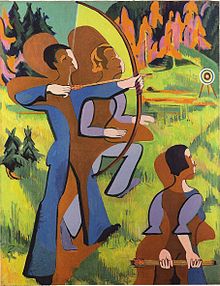
Source: Internet
Ernst Kirchner (1880 – 1938) was a German expressionist painter and print-maker and one of the founders of the artists group Die Brücke or “The Bridge”, a key group leading to the foundation of Expressionism in 20th-century art. He volunteered for army service in the First World War, but soon suffered a breakdown and was discharged. In 1933, his work was branded as “degenerate” by the Nazis and in 1937 over 600 of his works were sold or destroyed. In 1938 he committed suicide by gunshot.
In 1913, the first public showing of Kirchner’s work took place at the Armory Show, which was also the first major display of modern art in America. In 1921, U.S. museums began to acquire his work and did so increasingly thereafter. His first solo museum show in the US was at the Detroit Institute of Arts in 1937. In 1969, a major retrospective of paintings, drawings,and prints traveled to the Seattle Art Museum, the Pasadena Art Museum, and the Museum of Fine Arts, Boston. In 1992, the National Gallery of Art, Washington, held a monographic show, using its existing collection; a major international loan exhibition took place in 2003. In November 2006 at Christie’s, Kirchner’s Street Scene, Berlin (1913) fetched $38 million, a record for the artist. In 2008 (August 3 – November 10), the Museum of Modern Art in New York held a major exhibition that “probably comprises the very best of his oeuvre.”
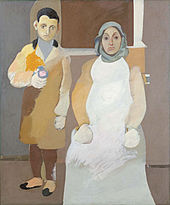
Arshile Gorky (1904 – 1948) was an Armenian-American painter, who had a seminal influence on Abstract Expressionism. In 1922, Gorky enrolled in the New School of Design in Boston, eventually becoming a part-time instructor. During the early 1920s he was influenced by Impressionism, although later in the decade he produced works that were more postimpressionist. During this time he was living in New York and was influenced by Paul Cézanne. Gorky’s contributions to American and world art are difficult to overestimate. His work as lyrical abstraction was a “new language. He “lit the way for two generations of American artists”. The painterly spontaneity of mature works like The Liver is the Cock’s Comb (1944), One Year the Milkweed (1944), and The Betrothal II (1947) immediately prefigured Abstract expressionism, and leaders in the New York School have acknowledged Gorky’s considerable influence.

